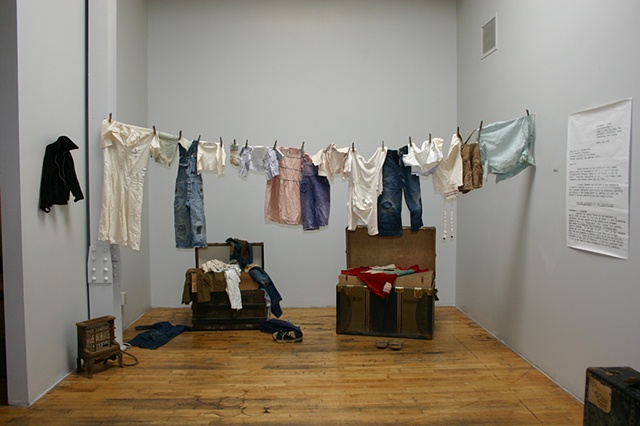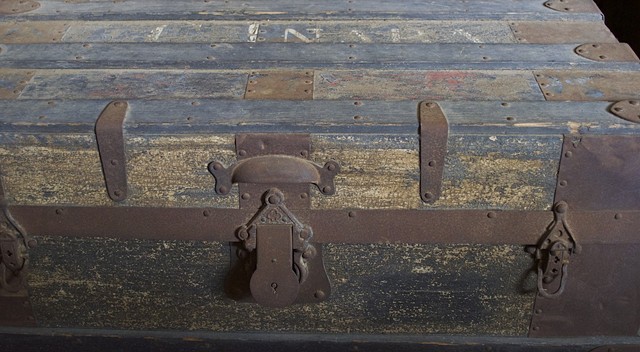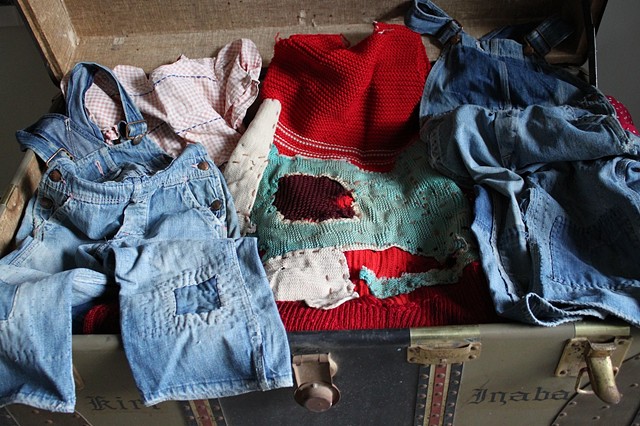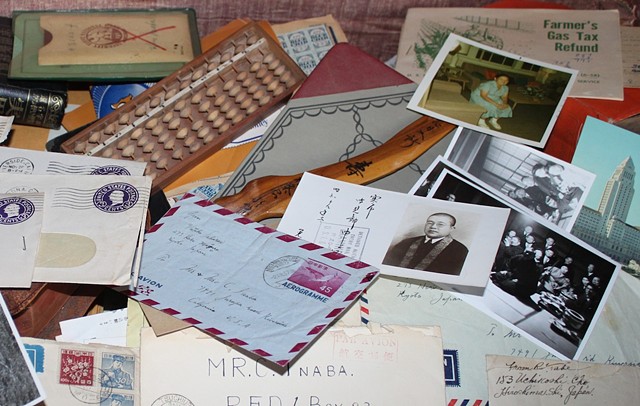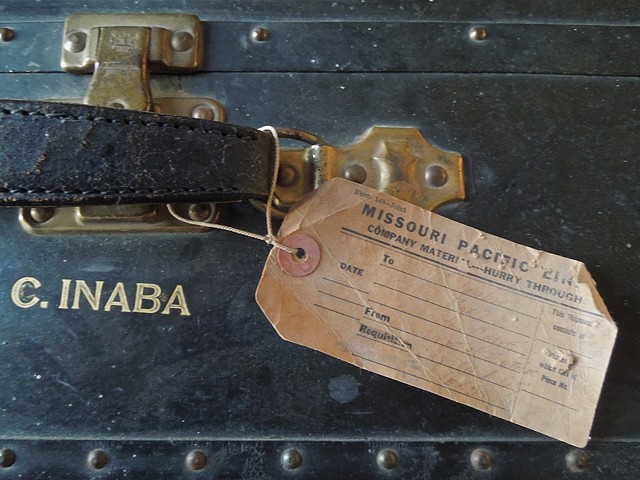The Trunks
The Trunks
by Reiko Fujii
As my mother, aunts, uncles, and I rummaged through the boxes and musty trunks in the barn and under the tractor shed, I was thrilled to discover relics from my mother’s family’s past. Still tied to one of the trunks was a worn-out tag that read “MISSOURI PACIFIC LINES — COMPANY MATERIAL — HURRY THROUGH.” Although faded, my grandfather’s name and address were clearly printed on the lines below. The trunks were filled with old baby clothes, worn and faded little girls’ dresses, boys’ mended coveralls, a woman’s threadbare dress, and old-fashioned one-piece bathing suits. I was witnessing the truth of the words I had heard throughout my life, “Grandma never threw anything away.”
Grandpa had passed away in December 1979. After Grandma died in May 1984, one of her twenty-three grandchildren decided to stay on the farm and raise his family there. Our beloved Inaba farm continued to stay in our family, extending this legacy to a total of four generations, eighty years.
Grandpa had built the barn and the chicken houses and worked in the fields until he was seventy. Grandma had collected eggs, weeded the fields, and cleaned the chicken coops from dawn until dusk every day since she came from Japan to marry Grandpa in 1924. Their seven children were brought up on the land. The oldest ones had been born in their small home, which was a remodeled chicken house. Grandpa had added on a bedroom, a closet, and a small bathroom. The family took their baths in a Japanese-style bathhouse called an % ofuro,% which was located outside the main house. Eventually, the old house was replaced with a new modern house, but everyone still took baths in the ofuro.
In 2002 the unimaginable happened. The farm was sold to a developer and would be completely demolished, making way for a new housing track. Almost everything had to be given away or sold.
“Where did these trunks come from?” I wondered out loud. Aunt Haru remembered, “The metal ones were ordered through the Sears Roebuck catalog. Grandpa made the wooden trunks.” Uncle Aki, looking over the rim of his glasses, was reminded, “My dad was not only the camp barber, he was also a talented carpenter and handyman. He was called the ‘Fix-it’ man in camp because he had a shop set up in a small trailer.”
I crouched over the old trunks, keepers of forgotten memories from sixty years ago. As I examined every piece of tattered clothing, my seventy-five-year-old mother and her younger sister, Haru, recalled their experiences as prisoners in the Manzanar concentration camp and Crystal City “family” camp. I discovered a wadded-up brown, red, and multicolored hand-knitted sweater-vest buried beneath the old children’s clothes. This should be thrown out I thought. My mother held it up and then turned it right side out. “Mom made this in camp,” she recalled. “She kept adding to it, using up leftover yarn. She even wore it after she returned to the farm because it kept her warm in the wintertime.” With loose ends of yarn poking out here and there, I could see that my grandmother meticulously mended her frayed vest over and over again. % We had better keep this vest after all. It was a part of not only Grandma’s life but also American history,% I reflected.
Aunt Haru, a spry seventy-three-year-old, commented on a pair of worn-out young boy’s coveralls with tattered straps attached by safety pins, “Oh, I remember, Tony used to wear these kinds of coveralls when he was little. He sure got good use out of these!” Uncle Tony was born one month before Grandma and her seven children were forced to leave their farm to live in the desert at the Manzanar prison camp. Grandpa and his brother, Hideo, had been arrested on the streets of downtown Riverside as highly suspicious “enemy aliens” weeks before Uncle Tony was born.
How did my non-English-speaking, eight-months pregnant grandmother feel when the FBI agents, for no understandable reason, took her husband away in their black car? How did she and her children prepare to leave their chickens and farm for an unknown amount of time? How were they going to be able to keep their property? Aunt Haru had heard her father explain, “After the war broke out, we still owed half the payment on the farm. We had about five thousand chickens when we were forced to leave. We sold all of the chickens. We sold almost everything and paid off the rest of the land. This was how we were able to keep the farm.”
Almost a year and a half passed before the government allowed Grandpa to be reunited with Grandma and their seven children at the Crystal City “family” prison camp in Texas. Grandpa met his youngest son, Tony, for the first time when he was a toddler.
As they rummaged deeper into the trunks, Aunt Haru and Mom found old-fashioned bathing suits at the bottom of one. “Crystal City had a swimming pool that everyone helped to build. We all went swimming there. It was the only way to cool down from the intense summer heat. One day, two of the Japanese Peruvian girls drowned,” Aunt Haru sadly remembered. “Japanese from South America were imprisoned there because they were kidnapped by the U.S. government to be used in hostage exchanges with the Japanese government.”
I later found out that 2,264 men, women, and children from twelve Latin American countries were forcibly deported to the United States during the war. When the war ended, they were not allowed back into their former countries, and the United States did not want them to stay here because they were considered illegal aliens. As a result, most of the Japanese from South America lost everything, including their country. [note no.1]
The knitted garment, the coveralls, the bathing suits—all these old clothes worn by my mother, aunts, and uncles in the prison camps—were pungent reminders of a dark slice of American history. I could now look at and touch the loose threads and fabrics, a tapestry symbolizing the experiences of 120,000 Nisei and Issei in the deserts where they were forced to live. Although my grandparents’ family was one of the few who did not lose their property during the war, they suffered racial prejudice, monetary loss, and theft of their personal belongings.
As the trunks were closed, sealing my family’s past in darkness, it became clearer to me that the ramifications from my family’s unjust imprisonment, especially the psychological trauma, were continuing to haunt not only them, but also my generation.
Reiko Fujii
1. Roger Daniels, Sandra C. Taylor, and Harry H. L. Kitano, eds., Japanese Americans: From Relocation to Redress, rev. ed. (Seattle: University of Washington Press, 1991).
